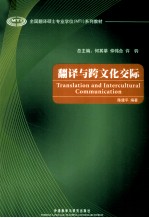

翻译与跨文化交际PDF电子书下载
- 电子书积分:10 积分如何计算积分?
- 作 者:陈建平编著;何其莘,仲伟合,许钧主编
- 出 版 社:北京:外语教学与研究出版社
- 出版年份:2012
- ISBN:9787513524476
- 页数:238 页
Part 1 Intercultural Communication in Translation 翻译中的跨文化交际因素 1
1.1 The Interconnectedness Between Translation and Intercultural Communication 2
1.2 Approaches to Intercultural Communication Studies 3
1.2.1 The Scope of Intercultural Communication 3
1.2.2 The Rationale for Intercultural Communication Studies 5
1.2.3 Intercultural.Intracultural and Cross-cultural Communication 8
1.2.4 The Contextual Model and the Sociolinguistic Approach 10
1.3 The Themes of This Introductory Course 15
1.4 Workshop 17
1.4.1 Translation and Studies in Communication&Culture 17
1.4.2 The Problems of Translation and Equivalence 19
1.4.3 Translatability of Cultural Perspectives 25
1.4.4 Practice in Translating Culture 30
Suggested Readings 38
Part 2 Language and Communication 语言与交际 41
2.1 Understanding Communication 42
2.1.1 The Process of Communication 44
2.1.2 The Features of Human Communication 46
2.1.3 The Relationship Between Communication and Culture 49
2.1.4 Dimensions for Assessing Communicative Differences Across Cultures 51
2.2 Understanding Language and Communication 52
2.2.1 The Nature of Language as Communication 52
2.2.2 The Patterns and Functions of Communication 55
2.3 Understanding the Concept of Communicative Competence 57
2.3.1 Defining a Competent Communicator 57
2.3.2 Implications for Foreign Language Learning and Translation Practice 58
2.4 Workshop 63
2.4.1 Basic Notions in the Analysis 63
2.4.2 A Comparative Analysis of a Communicative Event Across Cultures 67
2.4.3 A Comparative Analysis of Bilingual Introductions to Universities in China 72
Suggested Readings 79
Part 3 Language and Culture 语言与文化 81
3.1 Understanding Culture 82
3.1.1 The Nature of Culture 82
3.1.2 The Basic Elements of Culture 85
3.2 Language and Cultural Thought Patterns 89
3.2.1 Language and Cultural Perception 89
3.2.2 Language and Thought Patterns 93
3.3 Language and Cultural Contexts 97
3.3.1 High-context Culture vs.Low-context Culture 98
3.3.2 Individualistic vs. Collectivistic Cultural Context 104
3.4 Workshop 109
3.4.1 Cultural Presuppositions 109
3.4.2 Differences in Cultural Presupposition 111
3.4.3 Structural Differences vs. Cultural Differences 115
3.4.4 An Illustration of Language and Context 121
3.4.5 Culture Shock 122
Suggested Readings 126
Part 4 Language and Society 语言与社会 129
4.1 Language and Language Varieties 130
4.1.1 Language and Variation 130
4.1.2 Language and Dialect 132
4.2 Language and Social Variation 135
4.2.1 Language and Social Backgrounds 135
4.2.2 Language and Occupation 140
4.3 Bilingualism and Multiculturalism 143
4.3.1 Monolingualism vs. Bilingualism 143
4.3.2 Multiculturalism 146
4.4 Workshop 148
4.4.1 Speech and Identity 148
4.4.2 Language and Gender 150
4.4.3 Language and Nation 155
4.4.4 The Language of Stock Exchanges 158
4.4.5 Multilingualism and Translation Problems in the European Union 162
Suggested Readings 167
Part 5 Intercultural Discourse 语篇与文化 169
5.1 Culture and Speech Acts 170
5.1.1 Communication and Speech Acts 170
5.1.2 Speech Acts and Culture 176
5.2 Culture and Politeness 180
5.2.1 The Notion of Face and Politeness Strategies 180
5.2.2 Politeness Strategies of Involvement and Independence 184
5.3 Culture and Discourse Patterns 187
5.3.1 Culture and Discourse Structure 187
5.3.2 Cultural Patterns of Rhetoric 192
5.4 Workshop 195
5.4.1 Different Cultures,Different Speech Act Sets 195
54.2 Chinese EFL Students' Characteristic Paragraph and Essay Structure 200
5.4.3 An Illustration of a Typical Chinese Discourse Pattern 207
5.4.4 A Comparison of New Year Messages 213
5.4.5 Discussion of the Application of the Notion of Genre in Translation 220
Suggested Readings 222
References 参考书目 225
- 《东北民歌文化研究及艺术探析》(中国)杨清波 2019
- 《英汉翻译理论的多维阐释及应用剖析》常瑞娟著 2019
- 《大学英语教学的跨文化交际视角研究与创新发展》许丽云,刘枫,尚利明著 2020
- 《当代翻译美学的理论诠释与应用解读》宁建庚著 2019
- 《跨文化交际背景下的中西文化比较研究》任永进,贺志涛著 2019
- 《生态文化建设的社会机制研究》阮晓莺著 2019
- 《党内政治文化建设指南》苏玉主编 2017
- 《白纻舞及其歌辞的文化解读》王俊,曹化根著 2019
- 《社会文化系统中的翻译》姜秋霞,杨正军 2019
- 《2020考研英语大趋势 历年真题完形+翻译+新题型精讲精练》商志 2019
- 《市政工程基础》杨岚编著 2009
- 《家畜百宝 猪、牛、羊、鸡的综合利用》山西省商业厅组织技术处编著 1959
- 《《道德经》200句》崇贤书院编著 2018
- 《高级英语阅读与听说教程》刘秀梅编著 2019
- 《计算机网络与通信基础》谢雨飞,田启川编著 2019
- 《看图自学吉他弹唱教程》陈飞编著 2019
- 《法语词汇认知联想记忆法》刘莲编著 2020
- 《培智学校义务教育实验教科书教师教学用书 生活适应 二年级 上》人民教育出版社,课程教材研究所,特殊教育课程教材研究中心编著 2019
- 《国家社科基金项目申报规范 技巧与案例 第3版 2020》文传浩,夏宇编著 2019
- 《流体力学》张扬军,彭杰,诸葛伟林编著 2019
